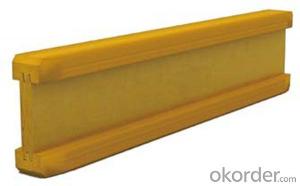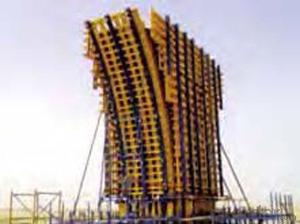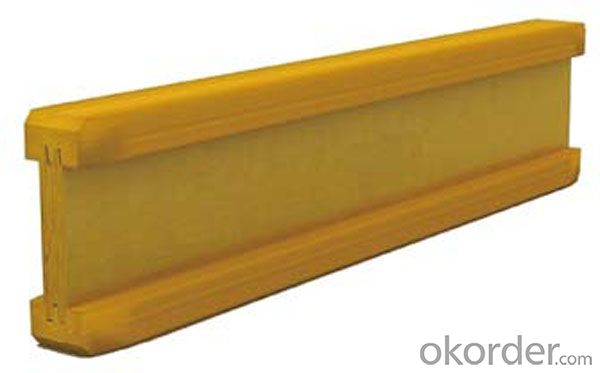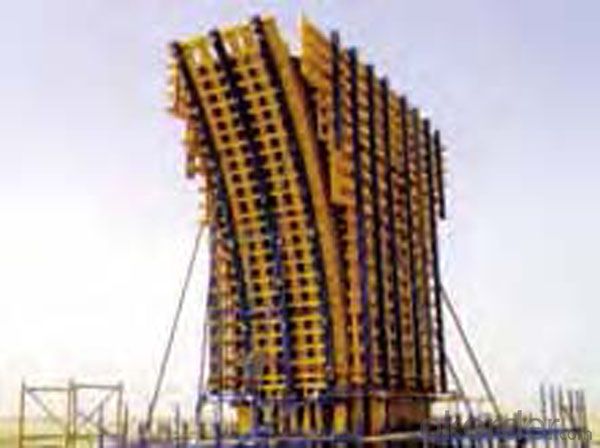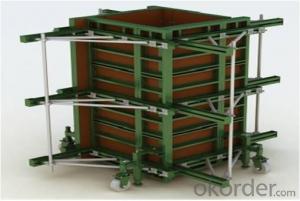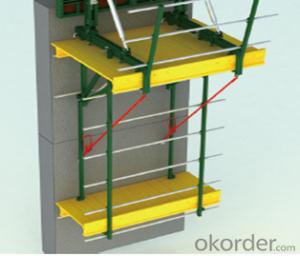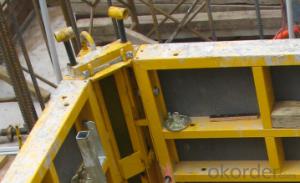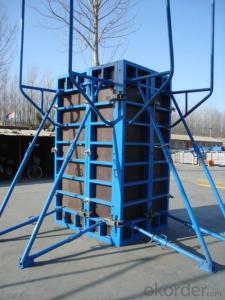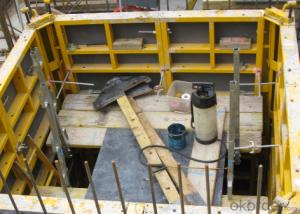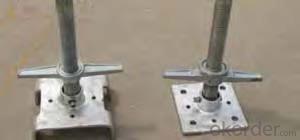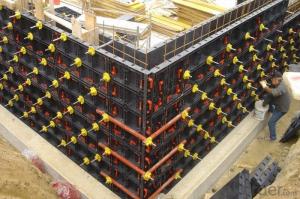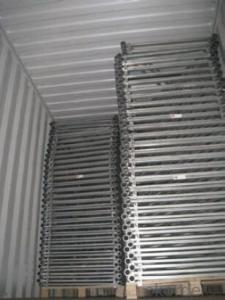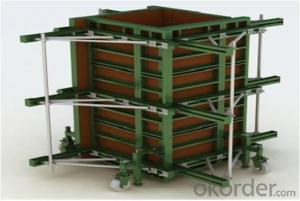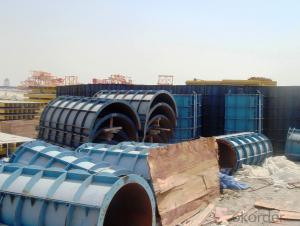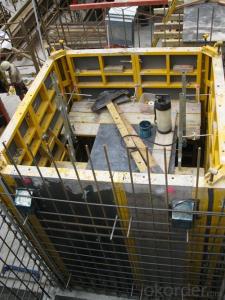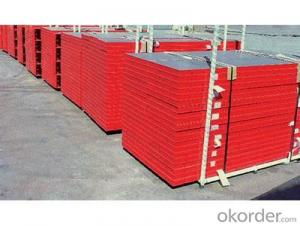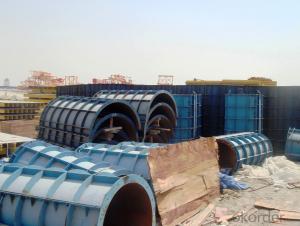Circular Column Formwork Outrigger for Scaffolding
- Loading Port:
- Tianjin
- Payment Terms:
- TT OR LC
- Min Order Qty:
- 5000 set
- Supply Capability:
- 50000 set/month
OKorder Service Pledge
OKorder Financial Service
You Might Also Like
Circular Column Formwork Outrigger For Scaffolding
Developing with new technology materials, steel formworks is no longer a must in construction concrete process. More and more buildings are established with plastic formworks. And workers love this new formworks much more.
The advantages of plastic formworks:
1.First of all--light
Yes it is the first advantage of plastic formwork. It wins the great praise of both contractors and workers.
The biggest panel is 120×1500px,weights 10.5kg only. It can be lift and set up by one person easily, which means there is no need for cranes on site.Saves a lot of cost and time.
2.Easy set up
Different size of panels can firmly locked by simply turn the special handles to 90 degree. The Panels has rib on the back, which makes the system need not traditional wood blocks and nails. The panels have holes to fit tie rod, guarantee the strength of the whole system.
4.Strength
The handles are made by high strength Nilon, each panel locked by at least 4 handles, which makes the whole system strong enough to pour 1000px walls.
5.Environment friendly
The system needs no cut and nail due to the variety size. Also it needs nearly no wood. The material can be recycled after broken, so it will not pollute the environment.
6.Consequent
Concrete does not stick to plastic formwork, thus the panels need no oil before using, and can be cleaned simply by water. The surface of the wall which build by modular formwork is smooth and without rework.
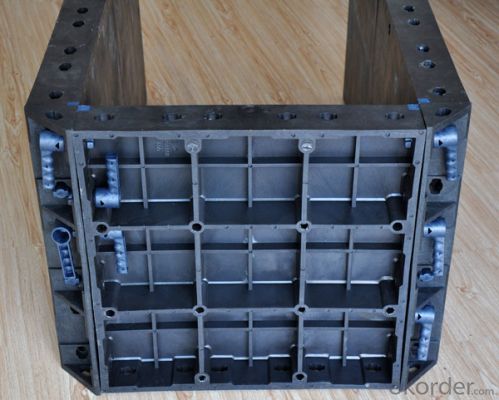
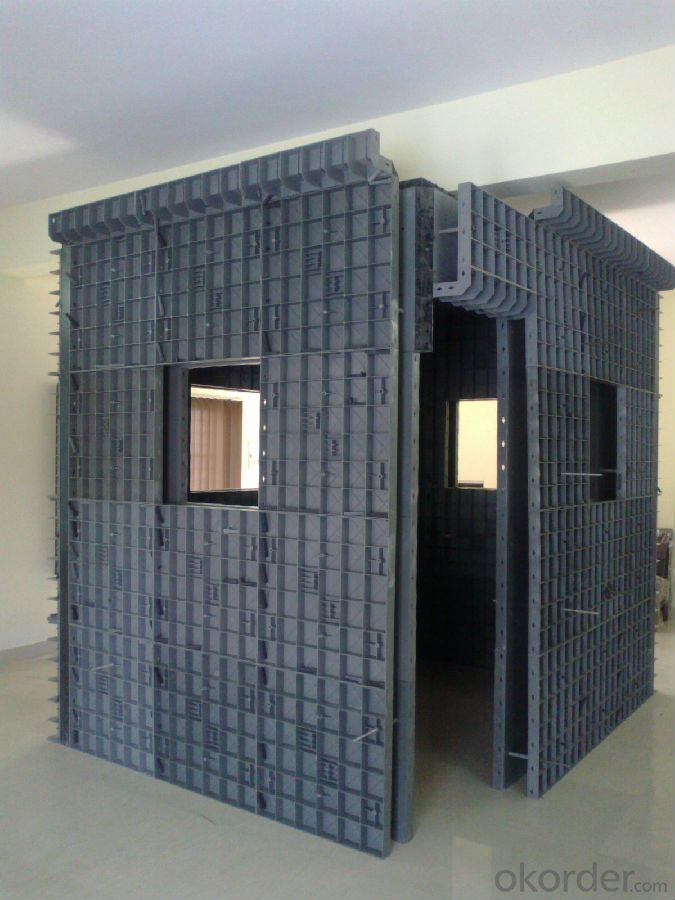
Advantage
* Good loading capacity
* Easy to assemble and dismantle
* Stable and durable thanks to its structual design & automatic welding quality
* Customized solution helps you work safe, save cost and convenient
* Excellent quality for formwork & scaffolding
Packing
in bulk or in bundle, or as requested
Shipping
15-20 Days.
Normally small orders, it needs just 15-20 business days to the port.
Other scaffolding & formwork products:
(1) Scaffolding System:
Including Ringlock Scaffolding System and accessories; Cuplock Scaffolding System and accessories; Kwikstage Scaffolding System and accessories; Haki Scaffolding System and accessories;
(2) Scaffolding Frame & Accessories:
Including Walk Through Frame Scaffolding; Ladder Frame Scaffolding; Accessories; we also can make scaffolding according to your samples or drawings.
(3) Scaffolding Couplers/Clamps:
We can produce all kinds of forged and pressed couplers, including British type couplers, American type couplers, German type couplers, Italian type couplers ,fence couplers, BRC coplers and so on. We also can produce according to your drawings or samples.
(4) Formwork System Scaffolding & Accessories:
Light Duty Shoring prop and Heavy Duty Shoring Prop; Wing nuts and Tie rods; RASTO clamp and so on.
FAQ
Why Us?
We are one of the Top 500 in the world, largest construction materials supplier in China. Also we are a state-owned company and respond to every customer with large and also small orders.
We own professional manufacturers with powerful producing capacity.
Extensive and comprehensive quality control system
Full energy with affluent experience team.
- Q: Are there any specific guidelines for pouring concrete into steel frame formwork?
- Yes, there are specific guidelines for pouring concrete into steel frame formwork. Here are some of the key guidelines to follow: 1. Ensure the formwork is properly secured: Before pouring the concrete, make sure the steel frame formwork is securely anchored to prevent any movement or displacement during the pouring process. This will help maintain the structural integrity of the concrete once it sets. 2. Prepare the formwork: Clean the steel frame formwork thoroughly before pouring concrete. Remove any debris, dust, or loose particles that may affect the quality of the concrete. Additionally, apply a release agent or formwork oil to the inner surface of the formwork to facilitate easy removal after the concrete sets. 3. Reinforce the formwork: If necessary, reinforce the steel frame formwork with additional steel bars or mesh to provide extra strength and stability. This is especially important for pouring large or complex structures that require additional reinforcement to withstand the pressure of the concrete. 4. Place concrete in sections: Pour the concrete in sections rather than filling the entire formwork at once. This will help prevent the concrete from settling or segregating, ensuring a consistent density and strength throughout the structure. 5. Compact the concrete: Use appropriate compaction techniques, such as vibrating or tamping, to eliminate any air pockets or voids within the concrete. This will enhance the structural integrity and improve the overall quality of the finished product. 6. Allow for proper curing: After pouring the concrete, ensure proper curing by providing adequate moisture and temperature conditions. This will help the concrete achieve its desired strength and durability over time. Follow the recommended curing guidelines provided by the concrete supplier or engineer. 7. Monitor the pouring process: Throughout the pouring process, closely monitor the concrete flow, ensuring it fills the formwork evenly and without any obstructions. Pay attention to any potential issues, such as leakage or excessive bleeding, and take necessary actions to rectify them promptly. Overall, following these specific guidelines for pouring concrete into steel frame formwork will help ensure a successful and structurally sound concrete structure. However, it is always recommended to consult with a professional engineer or concrete specialist for specific guidelines and recommendations based on the project requirements and local building codes.
- Q: Can steel frame formwork be used for sports and recreational facilities construction?
- Sports and recreational facilities construction can benefit from the utilization of steel frame formwork. This versatile construction system establishes a robust and long-lasting framework for concrete structures. It finds widespread application in various construction projects, including sports and recreational facilities. The strength and rigidity of steel make it an excellent option for the construction of large and intricate structures, such as stadiums, indoor arenas, swimming pools, and gymnasiums. Steel frame formwork easily bears the weight of the concrete and withstands the forces exerted by the structure. This guarantees the stability and integrity of the facility, creating a safe and functional space for sports and recreational activities. Furthermore, steel frame formwork offers design flexibility and allows for customization to meet the specific needs of the facility. It can be effortlessly adjusted and modified to accommodate unique architectural features, including curved walls, grandstands, and unconventional shapes. Architects and designers can thus create visually appealing and innovative sports and recreational facilities. Moreover, steel frame formwork is renowned for its durability and longevity. It can endure harsh weather conditions, heavy loads, and regular wear and tear, making it suitable for long-term use in sports and recreational facilities. The use of steel also contributes to the sustainability of the construction, as it is a recyclable material that can be reused or repurposed in the future. In conclusion, steel frame formwork proves to be an appropriate choice for the construction of sports and recreational facilities. Its strength, flexibility, and durability make it an ideal construction system to support the design and functionality of such structures.
- Q: Can steel frame formwork be used in projects with limited access to construction sites?
- Projects with limited access to construction sites can utilize steel frame formwork. This type of formwork is renowned for its versatility and adaptability, making it suitable for various construction projects, even those with restricted access. Designed to be lightweight and easy to assemble, disassemble, and transport, this formwork can effortlessly navigate through narrow spaces and tight corners, making it an ideal choice for construction sites with limited access. Furthermore, steel frame formwork provides high strength and durability, ensuring stability and safety throughout the construction process. It can withstand heavy loads and offers excellent support for concrete structures. Additionally, this formwork allows for efficient and speedy construction. Its modular design and adjustable features facilitate quick assembly and adjustments, reducing construction time and costs. This is particularly advantageous for projects with limited access, where time and space constraints are significant. To summarize, steel frame formwork is a suitable option for construction projects with limited access to sites. Its lightweight, versatile, and adaptable nature, combined with its strength and durability, make it an excellent choice for efficient and effective construction in challenging environments.
- Q: Can steel frame formwork be used for curved or irregularly shaped concrete structures?
- Yes, steel frame formwork can be used for curved or irregularly shaped concrete structures. Steel frames can be easily customized to match the desired shape and dimensions of the structure, allowing for flexibility and adaptability during the construction process. This makes steel frame formwork a suitable choice for creating curved or irregularly shaped concrete structures with precision and efficiency.
- Q: Does steel frame formwork require any specific edge protection measures?
- Specific edge protection measures are necessary for steel frame formwork. These measures are crucial to ensure worker safety and prevent accidents or falls from heights. Given that steel frame formwork is commonly used for construction purposes and involves elevated work, it is imperative to have appropriate edge protection measures in place. One prevalent method of edge protection for steel frame formwork involves installing guardrails or handrails along the exposed edges. These guardrails, typically made of sturdy materials like steel, serve as physical barriers to prevent accidental falls. They should be positioned at an appropriate height and capable of withstanding the required loadings as per safety regulations. In addition to guardrails, toe boards can be installed at the lower edge of the formwork to prevent falling materials or tools from posing hazards below. Made of plywood or similar materials, toe boards are securely fixed to the steel frame formwork to create a barrier. Furthermore, safety nets or catch platforms can be utilized as an additional measure for edge protection. These nets are placed below the working area to catch any falling objects or act as a secondary safety measure in case of a fall. It is crucial to properly install and regularly inspect safety nets, ensuring they meet relevant safety standards. It is worth noting that the specific edge protection measures required for steel frame formwork may vary based on local safety regulations and the height of the work being performed. Consequently, consulting relevant safety guidelines and seeking professional advice is essential to comply with necessary edge protection measures.
- Q: How does steel frame formwork handle different types of formwork accessories?
- Steel frame formwork is designed to be versatile and accommodate different types of formwork accessories with ease. These accessories include but are not limited to form ties, wedges, formwork clamps, and scaffolding brackets. One of the key advantages of steel frame formwork is its ability to securely hold these accessories in place. The steel frames are specifically designed to provide a strong and rigid structure, which ensures that the formwork accessories are firmly attached and do not move during the concrete pouring process. This is crucial for maintaining the integrity of the formwork system and ensuring a high-quality finish. The form ties, which are used to hold the formwork panels together, can be easily attached to the steel frames. The frames typically have pre-drilled holes or slots where the form ties can be inserted and secured. This allows for quick and efficient assembly of the formwork system, saving time and labor during construction. Wedges are another important accessory in steel frame formwork. They are used to tighten and secure the form ties, ensuring that the formwork panels are tightly sealed and do not leak or shift during concrete pouring. The steel frames are designed to provide a secure grip for the wedges, allowing for easy adjustment and tightening as needed. Formwork clamps are used to hold the formwork panels in place and prevent them from moving or shifting. These clamps can be easily attached to the steel frames, providing a strong and stable connection. They are adjustable and can accommodate different panel thicknesses, making them suitable for various construction projects. Scaffolding brackets are also commonly used with steel frame formwork to provide additional support and access for workers. These brackets can be easily attached to the steel frames, allowing for safe and convenient access to the formwork system. They are designed to withstand heavy loads and provide a stable working platform for construction activities. In summary, steel frame formwork is highly compatible with different types of formwork accessories. Its strong and rigid structure allows for secure attachment and efficient use of form ties, wedges, clamps, and scaffolding brackets. This versatility makes steel frame formwork a popular choice in the construction industry, as it can handle various types of formwork accessories with ease.
- Q: Can steel frame formwork be customized for different project requirements?
- Yes, steel frame formwork can be customized for different project requirements. Steel frame formwork systems are highly versatile and can be easily adjusted and modified to meet specific project needs. The frames can be designed and manufactured in different sizes and shapes to accommodate various structures and dimensions. Additionally, steel formwork can be customized with additional features such as adjustable panels, detachable components, and specialized accessories to enhance efficiency and productivity on different construction projects.
- Q: Can steel frame formwork be used for circular or cylindrical structures?
- Yes, steel frame formwork can be used for circular or cylindrical structures. Steel frame formwork is a versatile and flexible system that can be easily adjusted to form various shapes and sizes, including circular or cylindrical structures. The steel frames are designed to be adjustable and can be curved or bent to match the desired shape of the structure. Additionally, the formwork panels can be attached to the steel frames to create a seamless and continuous mold for pouring concrete. This allows for the construction of circular or cylindrical structures with precise dimensions and smooth finishes. Overall, steel frame formwork is a suitable choice for forming circular or cylindrical structures due to its adaptability and ability to create complex shapes.
- Q: Can steel frame formwork be used in projects with limited project duration or tight schedules?
- Projects with limited project duration or tight schedules can indeed utilize steel frame formwork. Steel frame formwork presents various advantages that make it appropriate for construction projects that require fast-paced work. Firstly, it is lightweight and easy to handle, enabling quick assembly and dismantling. This expedites the construction process, saving valuable time. Moreover, steel frame formwork is highly durable and can endure multiple uses, which is advantageous for projects with tight schedules as it allows for swifter concrete pouring and formwork re-use. Additionally, steel frame formwork is adjustable and versatile, offering flexibility in design and layout changes, which is crucial for projects with limited project duration. In summary, the implementation of steel frame formwork can enhance productivity, reduce construction time, and improve efficiency in projects with limited project duration or tight schedules.
- Q: Can steel frame formwork be used for both cast-in-place and precast wall construction?
- Yes, steel frame formwork can be used for both cast-in-place and precast wall construction. The versatility of steel frame formwork allows it to be easily adjusted and adapted to different construction methods, making it suitable for both cast-in-place and precast wall construction.
Send your message to us
Circular Column Formwork Outrigger for Scaffolding
- Loading Port:
- Tianjin
- Payment Terms:
- TT OR LC
- Min Order Qty:
- 5000 set
- Supply Capability:
- 50000 set/month
OKorder Service Pledge
OKorder Financial Service
Similar products
Hot products
Hot Searches
Related keywords
